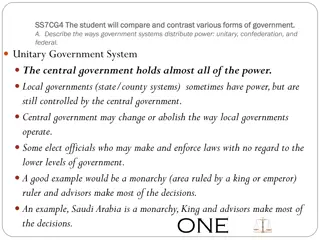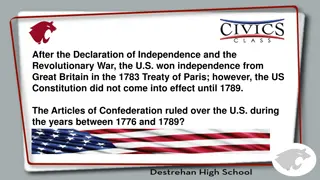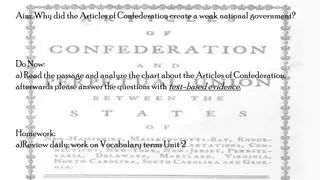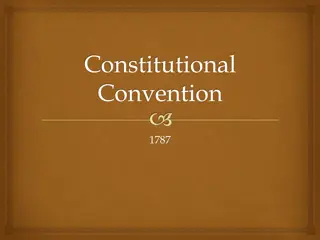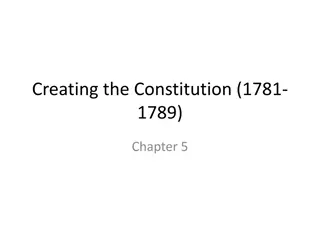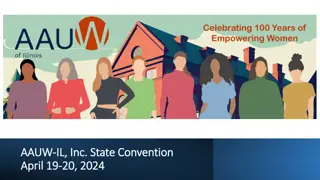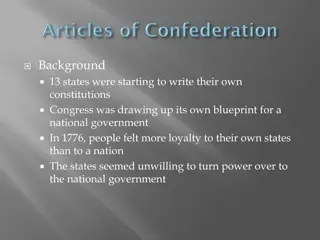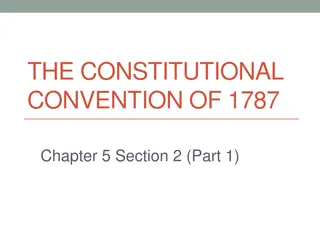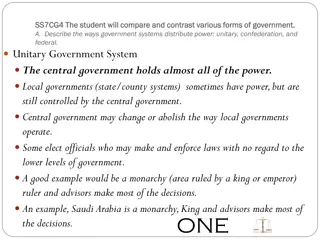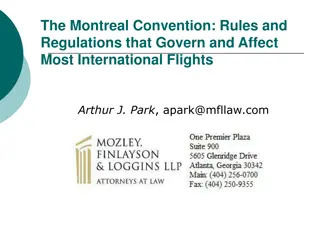Evolution of American Governance: From Articles of Confederation to Constitutional Convention
Explore the transition from the Articles of Confederation to the Constitutional Convention shaped by assumptions about government after the Revolution. Discover how James Madison identified problems with the Articles, leading to key issues like representation, federalism, executive responsibilities, and the contentious topic of slavery resolution.
Download Presentation

Please find below an Image/Link to download the presentation.
The content on the website is provided AS IS for your information and personal use only. It may not be sold, licensed, or shared on other websites without obtaining consent from the author.If you encounter any issues during the download, it is possible that the publisher has removed the file from their server.
You are allowed to download the files provided on this website for personal or commercial use, subject to the condition that they are used lawfully. All files are the property of their respective owners.
The content on the website is provided AS IS for your information and personal use only. It may not be sold, licensed, or shared on other websites without obtaining consent from the author.
E N D
Presentation Transcript
James Madison and The Creation of The American Republic-Chapter 5&6 JACK RAKOVE
Assumptions About Gvmt After the Revolution The people had a high level of public virtue Legislatures should reflect the commitment to the public good The executive branch should be weak They just broke away from a powerful and tyrannical king Sovereignty should reside among the states Again, to prevent the national government from gaining too much power These assumptions led to the creation of the Articles of Confederation
The Articles of Confederation A firm league of friendship. State-oriented No executive No judiciary No power to tax 2-7 delegates to the national legislature State sovereignty Each state had an equal vote Unanimous approval of states to amend the Articles
With a lack of real power, the Articles of Confederation struggled to Regulate trade Enforce decisions Resolve conflicts between states Conduct foreign policy Such serious problems called for a convention to amend the Articles to make them more efficient
James Madison and Problems with the Articles Under the Articles of Confederation, states produced laws that were mutable, multiple, and unjust Laws were easily changed There were several laws regarding the same thing Many laws were unjust to certain parties
Key Issues Representation What would the relationship between the national government and the people be? Federalism What would the relationship between the national government and the states be? Chief Officer It was essentially decided that George Washington would be the executive, but what would the responsibilities and limits of the executive be? Slavery How would the Convention accommodate such strong feelings from both the South and North to reach a compromise?
James Madison James Madison arrived early to the Constitutional Convention armed with a plan Seeing many of the problems surrounding the Articles of Confederation being rooted in issues with the states, Madison wanted to create a strong national government Having detailed plans of his own, Madison planned to persuade the other delegates instead of having to compromise with them Madison thought the key to a strong national government would be a strong national legislative branch
The Virginia Plan National Legislatures with 2 houses One house elected by the people and based on population size, the other house elected by the first house National Executive Chosen by legislature and would serve one 5-year term National Judiciary Chosen by legislature Council of Revision Executive and Judicial branches could review and veto national and state laws
The New Jersey Plan Legislative Branch: Would remain the same as under the A.o.C.; unicameral house with equal representation Executive Branch: A council serving a single term, subject to recall with states Judiciary Branch: Lifetime tenure
The Great Compromise Legislative Branch Lower House (House of Representatives) based on population Upper House (Senate) every state gets 2 representatives Executive Branch Elected through electoral college; limited veto power; 4 year terms Judicial Branch Life time terms; appointed by President
E.J. Dionne Although Madison faced quite a few rejections and was not keen to compromise, he did to avoid gridlock Many other delegates knew that compromise was the key to creating a successful Constitution Compromise has been a part of our country s history since the Founding, when many of our Founding Fathers compromised on ideas that were very important to them The Constitutional Convention Simulation will hopefully get you thinking about how difficult it can be to create something great out of compromise




